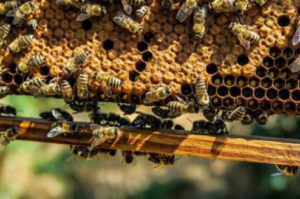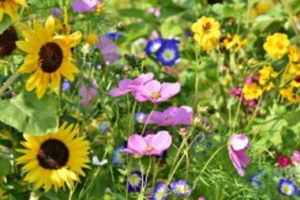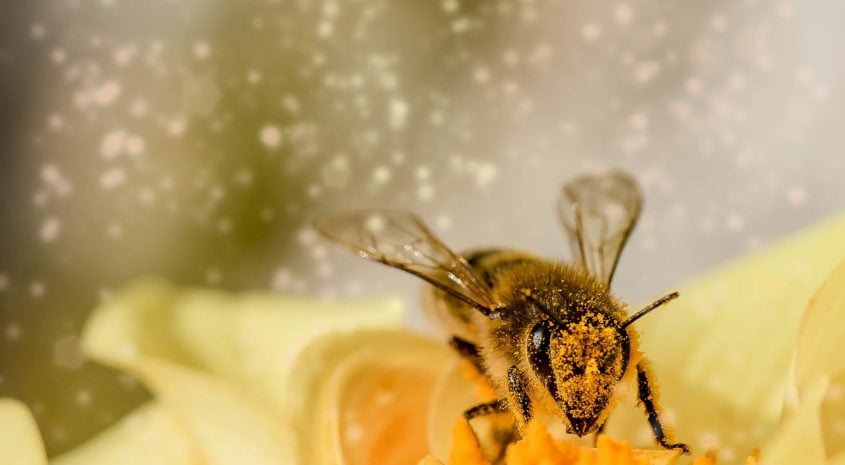Author: Eric Seeger Land Pro at UC Midwestlifestyle Properties
If you have thought about CPR Initiatives and haven’t taken the time to look at what is available, it’s about time you did! Whether you’re farming or maintaining your hunting land, CPR Initiatives are great investments. The USDA Pollinator Program CP 42 is a wonderful way to help boost our bee population and in turn, keep our plants producing seeds and reproducing.
BEE-LIEVE IT OR NOT

When you think of pollinators most folks think of bees. In addition to bees, moths, flies, butterflies, beetles, wasps, birds and bats provide pollination as well. Without these pollinators, many of our plants would not be able to seed or produce fruit. Pollination is vital to many industries as well as animals and their habitats.
BEE DATA
According to the American Beekeeping Federation:
- Honey bees contribute nearly $20 billion to the value of U.S. crop production.
- It’s estimated that there are about 2.7 million bee colonies in the U.S. today, two-thirds of which travel the country each year pollinating crops and producing honey and beeswax.
- Approximately one-third of all the food Americans eat is directly or indirectly derived from honey bee pollination. Some crops pollinated are cucumbers, almonds, carrot seed, melons, apricots, cherries, pears, apples, prunes, plums, pluots, seed alfalfa, cantaloupe, seed onions, avocados, kiwi, blueberries, cranberries, etc.
- The peak population of a colony of honey bees is usually at mid-summer (after spring build-up) and results in 60,000 to 80,000 bees per colony. A good, prolific queen can lay up to 3,000 eggs per day.
- When a queen is five to six days old, she is ready to mate. She puts out a pheromone scent to attract the males and takes off in the air. The males from miles around smell the scent and instantly volunteer in the mating chase, which is performed in the air.
- There are three members of a honey bee colony:
- Queen:Mother to all the bees in the colony. She is a fertile female.
- Worker: An infertile female that performs the labor tasks of the colony including feed preparation; guarding the hive; feeding the queen, drones, and brood; and heating and cooling the hive.
- Drone:The male that starts out as an unfertilized egg. Its only purpose in the colony is to mate with a virgin queen. They live to mate with the queen, but not more than one in a thousand get the opportunity to mate.
A HELPING HAND
A helpful incentive in the pollinator program is conservation technical assistance. The conservation technical assistance can provide you with:
- addressing opportunities, concerns, and problems
- provide you management for maintaining and improving your private land
- maintain and improve the aesthetic character of your private land
LandCan was developed to support private landowners across America. This is a wonderful resource for private landowners. They have an excellent Youtube video which is a must-see! Check out the interactive map, pick out your state and explore.
CRP and Pollinator Program (CP-42) provide legume-rich or diverse wildflowers. Through the CRP and Pollinator Program (CP-42), legume-rich or diverse wildflowers provide honeybees with a wealthy habitat.
JUST THE FACTS…

Image by Myriam Zilles from Pixabay
The USDA makes handy Pollinator pdf facts sheet. I highly recommend you print one out. According to the USDA Pollinator fact sheet, participators in the CP-42 are eligible to receive:
- Annual rental payments
- Cost-share payment covering up to 50 percent of the eligible cost of establishing the pollinator practice
- One-time $150 per acre SIP is available for CP-42 enrolled in the Continuous CRP
- Cost-share payment covering 50 percent of the cost of mid-contract management.

Image by Capri23auto from Pixabay
Participators have practice requirements, here a just a few:
- Acres selected for pollinator habitat must be at least 0.5 acres. Planting in blocks is preferred over strip plantings, but if planted in strips, each strip must be a minimum of 20 feet wide
- Grasses seeded in this practice must be native. Although native species are encouraged, beneficial introduced flowering plants (e.g., alfalfa and clover) may be part of the seeding mix if approved by USDA conservation planners
- Seeding mixes generally require a minimum of nine species of pollinator-friendly wildflowers, legumes, and/or shrubs, but states with arid areas may submit an alternative standard
As usual, the general contract terms for the program is 10 years. Contact your local county FSA office for forms needed for this program.
TO BEE OR NOT TO BEE… THAT IS THE QUESTION
It’s important to note that you do not need to become a “beekeeper”. There are several avenues to explore with having beehives on your property through your local beekeepers. BeeCulture.com is a great resource for getting in touch with local beekeepers. I also found this great interactive map courtesy of HeritageAcresMarket.com
In addition, the Federal government also has a pollinator program that is worth checking out.
Bees and other native pollinators make a wonderful CRP initiative to add to your hunting land by pollinating your legumes and fruit orchards.
Resources:
- https://www.fsa.usda.gov/Internet/FSA_File/pollinator_fact_sht.pdf
- https://www.nrcs.usda.gov/wps/portal/nrcs/main/national/programs/technical/
- http://pollinatorstewardship.org/index.php/funding-programs-for-pollinator-habitat/
- https://www.pollinator.org/programs
- https://www.landcan.org/?fbclid=IwAR3pq8t3Na2ZdAAHYVZW13kSYmtCrdxGE1RYFzKvqF20Jy5CSvGZ-eGw8RI
- https://wsfrprograms.fws.gov/Subpages/Pollinators/Pollinators.htm


